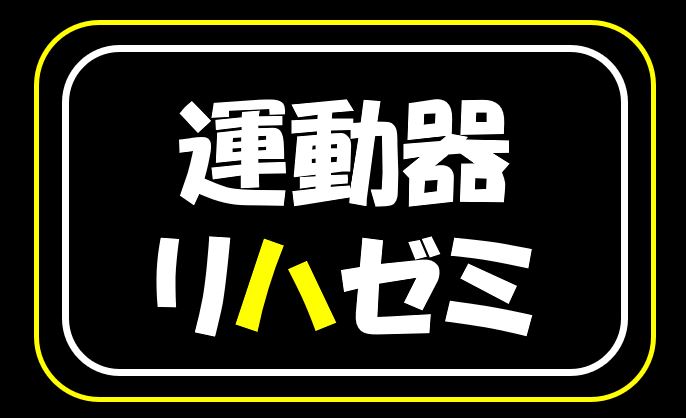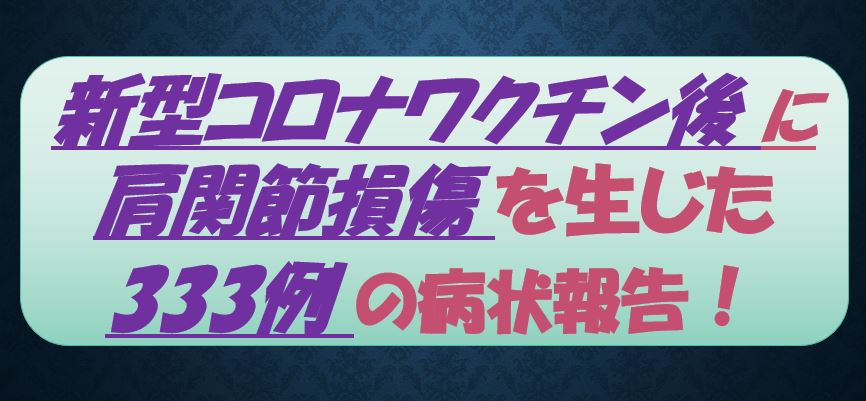こんにちは!
運動器専門のリハビリスタッフです!!
いつもお世話になります。
今回は、『新型コロナワクチン後に肩関節損傷を生じた333例の病状報告!』
について解説させていただきます。
2019年末に中国の武漢で発生した新型コロナウイルス感染症(COVIT-19)は、世界中に拡大し、日本でも2020年より感染が拡大しました。
日本においてのファイザー社の新型コロナワクチンが2021年2月14日に薬事承認され同月の17日より接種が開始されました。
新型コロナワクチンによる副反応として、摂取部位の疼痛や倦怠感、頭痛、発熱などの症状が頻繁に報告されているが、肩関節周囲炎症状を訴える症例も少なくない印象です。
そんな中、2022年に、新型コロナウイルスワクチン接種後に肩関節損傷を生じた症例の報告をした論文が海外で報告されております。
この論文の検証結果が気になるところですね。
◆論文紹介
Vaccine (IF: 3.64; Q3)
. 2022 Aug 12;40(34):4964-4971.
doi: 10.1016/j.vaccine.2022.06.002. Epub 2022 Jun 8.
Shoulder injury related to vaccine administration (SIRVA) after COVID-19 vaccination
COVID-19ワクチン接種後のワクチン投与に関連した肩の怪我(SIRVA)
Jessica R Bass 1, Gregory A Poland 2
Affiliations expand
- PMID: 35817645 PMCID: PMC9174179 DOI: 10.1016/j.vaccine.2022.06.002
Free PMC article
Abstract
Objective: The global fight against COVID-19 has required mass vaccination clinics as well as mass recruitment of personnel, including many who may not regularly administer intramuscular deltoid immunizations, potentially increasing the incidence of improper intramuscular injection. Shoulder injury related to vaccine administration (SIRVA) is a well-described, preventable injury resulting from improper injection into anatomic structures adjacent to the deltoid muscle leading to mechanical and chemical trauma augmented by an inflammatory immune response to the vaccine and/or adjuvants. SIRVA is best described in the setting of influenza vaccination, and little is known about it as it pertains to COVID-19 vaccination. This study aims to describe SIRVA in the current pandemic, increase clinician awareness, and offer considerations for prevention.
概要
目的 COVID-19に対する世界的な闘いは、大量のワクチン接種クリニックと同時に、三角筋内接種を定期的に行っていない可能性のある多くの人員を含む、大量の人員を必要とし、不適切な筋肉内注入の発生率を高める可能性がある。ワクチン投与による肩の損傷(SIRVA)は、三角筋に隣接する解剖学的構造への不適切な注射により、ワクチンやアジュバントに対する炎症性免疫反応によって増強された機械的・化学的外傷を引き起こす、十分に説明できる、予防可能な傷害である。SIRVAは、インフルエンザワクチン接種の設定で最もよく説明されており、COVID-19ワクチン接種に関連するそれについてはほとんど知られていない。本研究の目的は、現在のパンデミックにおけるSIRVAを説明し、臨床医の認識を高め、予防のための考察を提供することである。
Methods: To identify clinical characteristics of patients with post-COVID-19-vaccination shoulder injuries, we performed a systematic review of the cases of vaccination-related shoulder injuries reported in the literature and conducted a review of the public Vaccine Adverse Event Reporting System (VAERS).
方法 COVID-19ワクチン接種後の肩関節損傷患者の臨床的特徴を明らかにするため、文献に報告されているワクチン接種関連の肩関節損傷症例の系統的レビューを行い、公的なワクチン有害事象報告システム(VAERS)のレビューも実施した。
Results: We identified 305 cases of SIRVA in the VAERS database and 28 cases of SIRVA in the setting of COVID-19 vaccination from the literature (n = 333). Patients had a mean age of 51.8 years and a median of 51.5 (range: 19-90) years. Of these, 76.3% were female and 23.7% male. Most patients sought medical evaluation with 54 of the 305 VAERS cases reporting utilizing emergency services. Of patients with imaging-confirmed SIRVA (n = 95), the most common diagnoses were adhesive capsulitis and bursitis, and the most common symptoms were pain (97.7%) and limited range of motion (68.1%). Most patients reported requiring treatment with the majority receiving physical therapy (56.3%), followed by cortisone injection (34.4%). Other modalities used were non-steroidal anti-inflammatory drugs, oral steroids, and surgery. Only 5 patients from this group reported recovery while 60 stated they had not yet recovered. Of those, 23.3% reported disability.
その結果 VAERSデータベースから305例のSIRVAを,文献からCOVID-19ワクチン接種に伴うSIRVAを28例同定した(n=333)。患者の平均年齢は51.8歳、中央値は51.5歳(範囲:19-90)であった。このうち76.3%が女性で、23.7%が男性であった。ほとんどの患者は医療機関の診断を受け、305例のVAERSのうち54例が救急サービスを利用したと報告しています。画像診断でSIRVAが確認された患者(n = 95)のうち、最も一般的な診断は癒着性関節包炎と滑液包炎で、最も一般的な症状は疼痛(97.7%)と可動域制限(68.1%)であった。ほとんどの患者が治療を必要とし、大多数は理学療法(56.3%)を受け、次いでコルチゾン注射(34.4%)を受けたと報告されている。その他の治療法としては、非ステロイド性抗炎症薬、経口ステロイド剤、手術が用いられた。このグループから回復したと報告した患者はわずか5人であり、60人はまだ回復していないと述べた。そのうち、23.3%が障害を訴えた。
◆論文の結論
Conclusion: SIRVA should be regarded as an under-reported, significant cause of post-vaccination morbidity. In the setting of COVID-19 mass vaccination, clinicians must be aware of signs and symptoms of SIRVA as well as appropriate diagnostic modalities and treatment options. Additionally, standardization and proper education regarding injection technique and appropriate needle length is imperative to reducing harm.
結論 SIRVAは、十分に報告されていない、ワクチン接種後の罹患の重大な原因であると考えるべきであろう。COVID-19の集団接種の場では,臨床医はSIRVAの徴候や症状,適切な診断方法,治療法を知っておく必要がある.さらに、注射技術と適切な針の長さに関する標準化と適切な教育は、害を減らすために不可欠である。
◆まとめ
上記論文では公的なワクチン有害事象報告システム(VAERS)および様々な文献から、新型コロナワクチン接種後にSIRVA(肩関節損傷)を生じた333例を抽出し、症状についてまとめております。
新型コロナワクチン後の肩関節損傷333例
・平均年齢は51.8歳、中央値は51.5歳(範囲:19-90)
・76.3%が女性で、23.7%が男性。
・最も一般的な診断は癒着性関節包炎と滑液包炎。
・症状は疼痛(97.7%)、可動域制限(68.1%)であった。
・大多数は理学療法(56.3%)を受け、次いで肩関節ブロック注射(34.4%)を受けた。
・その他、非ステロイド性抗炎症薬、経口ステロイド剤、手術の治療が選択されている。
上記論文の結果を踏まえると、他の報告でもありましたが発生率は女性の方が高いようですね。また幅広い年齢層であり、ほぼ全例に疼痛を生じ、約7割の方に関節可動域制限が発生しているようです。
注射針の長さや上腕に打ち込む場所によっても肩関節損傷の発生率や症状が違う可能性がありますね。
今回は、『新型コロナワクチン後に肩関節損傷を生じた333例の病状報告!』
について解説させていただきました。



